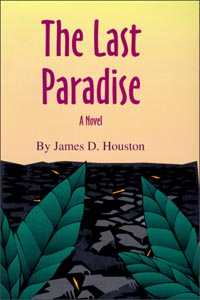Pele Power
The language rolls in like the waves in Jim Houston's novel
By J. Douglas Allen-Taylor
BACK IN THE DAYS when I was a lot younger and a lot less wise, I used to do really stupid stuff like walk home along the railroad track. One winter evening, I got caught by a train, right in at the spot where the trees dropped down so close to the track that there were only a couple of feet of clearance. I stood there in terror as the great engine and all its children roared past, knowing that a small slip on the gravel could send my body hurtling into oblivion--and thinking that I had the privilege of coming close to one of the great powers of all the world.
Ah, youth. Several years later, I found myself holed up in my apartment when Hurricane David blasted over the Southeast coast. About 3 in the morning, when winds hit the 100-mph mark and the cinder-block apartment house began vibrating on its foundations, I had time for long reflection on the comparative power of things made by humanity and things created by nature. The nature things won the contest, hands down.
The humans-vs.-nature struggle is at the heart of Santa Cruz writer James D. Houston's new novel, The Last Paradise. Representing the human-power is Energy Source, a subsidiary of Western Sun, "a sprawling multinational out of Houston, Texas, with wells and oil fields and uncountable miles of pipe pushed deep into the earth and into the sea." But Energy Source meets its match in Hawaii, where Pele, the island's volcanic goddess, angrily objects to the tapping of steam for the generation of electrical power.
A parallel story line explores the explosive reunion and cultural clash of two old lovers: Travis Doyle, a claims adjuster from the Bay Area who comes to Hawaii to investigate a mysterious fire at the Energy Source drilling site, and Angel Sakai, a Hawaiian native whose family claims descent from Pele herself.
By book's end, all of the characters--environmentalists, industrialists, natives and nonnatives alike--have faced the most terrible of forces: the ancient earth. Some make their peace and come to terms. Some--well, you're going to have to read the book to find that out.
AS ALWAYS with a Houston book, it is the haunting rhythm and gorgeousness of the writing itself which is the best treat, such as a scene in which Travis and Angel make love:
The passage also highlights an unsettling part of The Last Paradise: Houston's desire to look deeper into relations between men and women than perhaps we want to see. The author seems to sense a great gulf between the sexes, one that can be bridged by love but never completely closed.
"She knows it is one place she cannot take [Travis], to the lip of Pele's home and Malama's final resting place," the author writes of Angel and the volcano. But the feeling is there that perhaps Houston is really talking about Travis' inability to ever enter the fiery core of Angel's own heart.
Houston plays a lot with time and space in The Last Paradise, and the narrative line flows easily between the novel's present tense and Travis' reminiscences of times past. For Houston, tropical Hawaii is one of those places where the "normal" sense of time is lost, stories can run both backward and forward, and ancient legends arise to battle modern foes.
There is only one awkward note in the novel: the many coincidences that salt the narrative. When Travis accidentally runs into Angel at an environmentalist demonstration in front of the drilling site, it is plausible and acceptable because it sets many of the story lines in motion. But throughout the book, Travis and Angel continue to "just happen to" run into each other at times and places that are contrivingly convenient for the advancement of the plot. These instances are so obvious that the book jacket feels the need to note them and call them "uncanny." Houston is such an experienced writer that it is certain he did this to make a point. Unfortunately, it was a point I didn't get.
Generally, a weakness in the plot dooms a book, but Houston's sheer writing ability rescues The Last Paradise. He has given us a story that invokes the mood of the tropics itself, where the whole geography of the rain-forest floor can change completely in an afternoon's deluge, where one great blast from a volcano's maw can erase all the old paths along the moonscaped foothills and create them anew and where nothing, therefore, is as it seemed it was yesterday.
[ San Jose | Metroactive Central | Archives ]
Copyright © Metro Publishing Inc. Maintained by Boulevards New Media.
![]()
 Volcanic: The ancient island powers rebel in 'The Last Paradise.'
Volcanic: The ancient island powers rebel in 'The Last Paradise.'
The Last Paradise
By James D. Houston
University of Oklahoma Press; 364 pages; $22.95 cloth
A wave begins to throb, like a sound wave, pulsing outward. That is how it seems to Travis, something he can see from somewhere behind his mind's eye and hear from somewhere behind his ears, throbbing outward in a slow crescendo that makes one long undulant roll, and he is in it, rushing invisible, wingless, borne forth upon a broad band, a violet glow pulsing against the dark of night, the band so broad and thick it becomes a pool of violet, spreading the way they say the universe spreads, or curves. ... And Angel is not with him. She is here. Yet she is not. She is plunging toward some source of heat far below them, heat rising from below the bed, from below the room, below the grounds outside the room, below the island, below the sea, and the dark sea floor, the deepest chambers of the island-birthing heat. Is it rising? Or is she sinking toward it?
From the June 25-July 1, 1998 issue of Metro.
![[Metroactive Books]](/books/gifs/books468.gif)